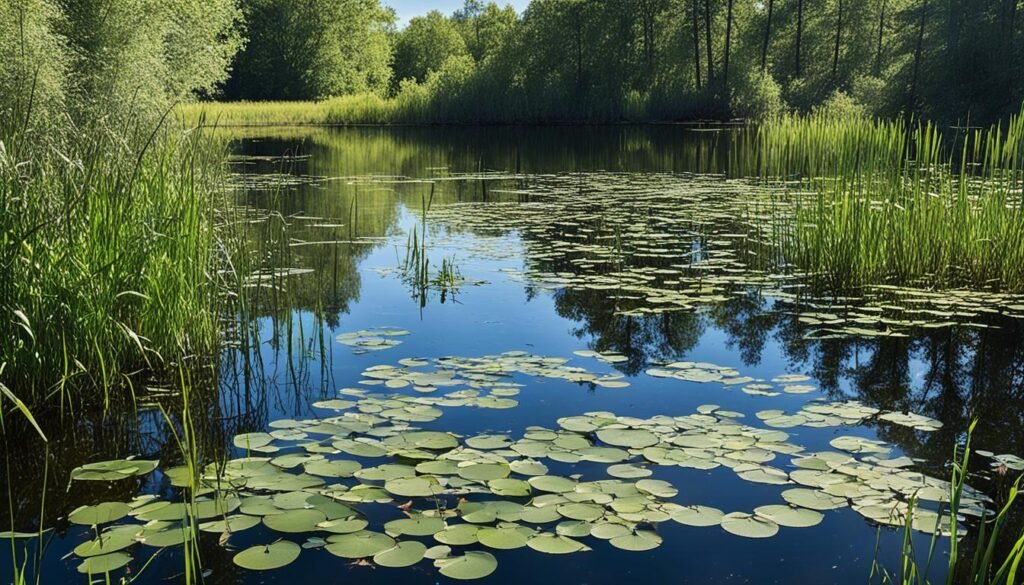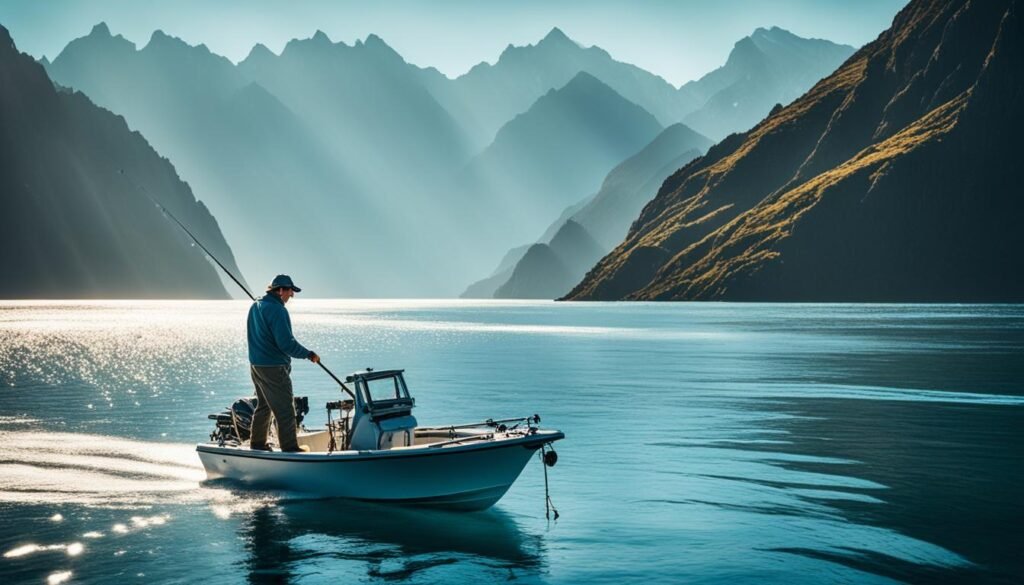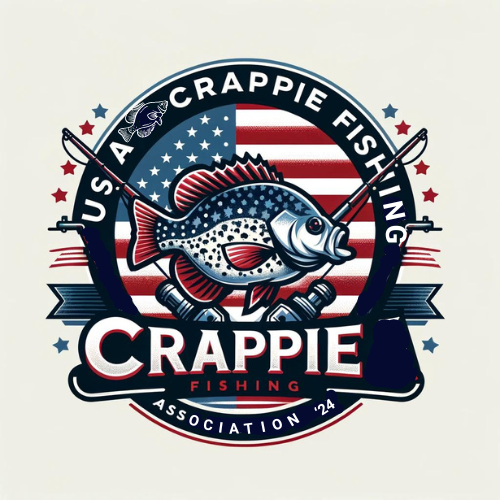If you’re an avid angler looking for the best crappie fishing techniques and secrets, then you’ve come to the right place. I’ve discovered the crappie holy grail that will significantly improve your chances of reeling in those prized crappie. The key lies in understanding the importance of brush piles and how they can serve as the ultimate crappie fishing hotspot.
Brush piles, whether manmade or natural, create the perfect habitat for crappie. These structures should ideally be placed in around 12-15 feet of water, which is ideal for pre-spawn and post-spawn crappie. It’s also the ideal depth before crappie move to deeper waters in the winter. Utilizing electronics to locate these brush piles can greatly increase your chances of success on your fishing trips.
Key Takeaways:
- Brush piles can be the ultimate crappie fishing hotspot.
- They should be placed in around 12-15 feet of water.
- Utilizing electronics can greatly increase your chances of success.
- Understanding the seasonal patterns of crappie is crucial for success.
- Brush piles provide crappie with cover and a good supply of bait fish.
Finding the Best Locations for Brush Piles
When it comes to crappie fishing, finding the best locations for brush piles is crucial. The optimal placement of brush piles depends on the time of year and the seasonal patterns of the crappie population in the lake you are fishing. By understanding these factors, you can increase your chances of success and reel in more crappie.
In the spring, crappie move to spawning coves or creeks, making these areas ideal for brush pile placement. The crappie are actively seeking out suitable spawning beds, and the brush piles provide excellent cover for them. By targeting these areas, you can tap into the crappie’s natural instinct and increase your catch rate.
In the summertime, crappie often move to main lake flats. These areas provide abundant food sources and ample space for crappie to roam. Placing brush piles on main lake flats can attract crappie and offer you a chance to land some trophy-sized fish.
During the winter months, crappie tend to gravitate towards the main creek channels. These areas provide a consistent food source and stable water temperatures. Placing brush piles near the main creek channels can help you locate crappie even in colder conditions.
Learning the seasonal patterns of the crappie population in the lake you are fishing is essential. By understanding where crappie bed and migrate during different times of the year, you can strategically place your brush piles and increase your chances of a successful fishing outing.
Creating a visual representation of the best locations for brush piles can help you plan your fishing trips more effectively. Here is a table summarizing the ideal brush pile placements based on the season:
| Season | Best Location for Brush Piles |
|---|---|
| Spring | Spawning coves or creeks |
| Summer | Main lake flats |
| Winter | Near main creek channels |
The Benefits of Sycamore Trees for Brush Piles
When it comes to creating effective brush piles for crappie fishing, choosing the right type of wood is crucial. One of the best species to use for brush piles is the sycamore tree. Sycamore trees have unique qualities that make them ideal for creating successful crappie fishing spots.
Natural Water Retention
Sycamore trees have a natural ability to hold water within their core. This unique characteristic allows sycamore logs to sink easily when weighted down. By using these logs, you can quickly create brush piles that will attract and hold crappie in your desired fishing area.
Ease of Installation
Creating a brush pile with sycamore trees is a simple process. With just one concrete block, you can sink a 16-foot long and 10-foot wide piece of sycamore. This efficient installation method saves time and effort, allowing you to focus on finding the top crappie fishing spots.
Increased Success with Strategic Placement
Placing brush piles made from sycamore trees in strategic locations can significantly increase your chances of catching a mess of hog crappie. By utilizing your fishing electronics to identify underwater structures and preferred crappie habitats, you can strategically position your brush piles to attract more fish.
With the benefits of sycamore trees for brush piles, you can enhance your crappie fishing tricks and tactics. Whether you’re a seasoned angler or just starting out, incorporating sycamore brush piles into your fishing strategy can lead you to the top crappie fishing spots.
| Benefits of Sycamore Trees for Brush Piles |
|---|
| Natural water retention |
| Ease of installation |
| Increased success with strategic placement |
The Power of Natural Laydowns
When it comes to crappie fishing, one of the most effective techniques is targeting natural laydowns. These fallen trees provide excellent cover and create a highway for crappie to move up and down, making them ideal homes for these elusive fish. The best part is that you don’t need advanced fishing electronics to locate them, as they can be easily spotted from both the bank and the boat.
Whether you are fishing in the spring, summer, or fall, natural laydowns offer a reliable option for targeting crappie. In the spring, crappie move towards the shallows for spawning, and these fallen trees provide the perfect structure for them to lay their eggs. During the summer, crappie seek shade and cover, especially during the hottest parts of the day, and natural laydowns offer exactly that. In the fall, as crappie start to move into deeper waters, these structures can still hold fish looking for an easy meal.
Not only do natural laydowns attract crappie, but they also attract other baitfish and organisms, creating a food chain that draws in these hungry predators. By targeting natural laydowns, you can take advantage of this natural feeding frenzy and greatly increase your chances of success.
To effectively fish natural laydowns, consider using the following techniques:
- Cast close to the structure and allow your bait or jig to sink naturally into the crevices of the fallen tree.
- Retrieve your bait slowly and vary your presentation to find what entices the crappie.
- Use lightweight tackle and smaller lures to match the size of the forage the crappie are feeding on.
- Experiment with different colors and patterns to find the most effective combination for the conditions.
By incorporating these techniques into your crappie fishing arsenal, you can maximize your success when targeting natural laydowns. Remember to always respect the environment and obtain the necessary permits and permissions when fishing on private or restricted lands. Happy fishing!
The Appeal of Stake Beds
Stake beds are a classic crappie structure that holds the key to crappie fishing success. These vertical structures create an ideal environment for crappie to move up and down the water column, making them the perfect spot to catch these elusive fish. While stake beds may not hold as many fish as brush piles, they have the potential to yield larger crappie, offering exciting opportunities for anglers.
Placing stake beds in the lake can be more challenging than other structures, but the rewards can be worth it when you find the right spot. The key is understanding the behavior of crappie and their preferences for these unique structures. By strategically positioning stake beds and using effective fishing techniques, you can unlock the secrets to catching crappie like a pro.
“Stake beds are like magnets for big crappie. They provide the perfect hideout and feeding ground, attracting the larger, more experienced fish. If you want to catch trophy-sized crappie, stake beds are where you need to be.”
– Expert Angler
The Advantages of Stake Beds:
- Vertical structure allows crappie to move freely in the water column
- Potential for catching larger, trophy-sized crappie
- Create a natural feeding ground for crappie
- Provide excellent hiding spots and cover for crappie
- Add variety to your fishing arsenal for different fishing conditions
| Advantages | Disadvantages |
|---|---|
| Attracts larger crappie | More challenging to place in the lake |
| Offers vertical structure | Require careful positioning to optimize effectiveness |
| Provides better hiding spots | May not hold as many fish as brush piles |
The Attraction of Structure for Crappie
Crappie fishing tricks and tactics often revolve around understanding the appeal of structure for these elusive fish. Structure provides crappie with the necessary cover and a plentiful supply of bait fish, making it an ideal habitat for them to thrive. Two common types of structure that crappie are drawn to are brush piles and laydowns.
Brush piles offer crappie a place to hide and forage for food. These manmade or natural wood structures can be strategically placed in the water to create hotspots for crappie fishing. The crappie will bury themselves within the brush piles to escape predators and eagerly strike a jig that lands in the middle of the structure.
Understanding the appeal of structure can help you target crappie more effectively. By focusing your efforts around brush piles and laydowns, you can increase your chances of success on your next fishing trip.
It’s important to note that locating brush piles and laydowns can be made easier with the use of fishing electronics. By mapping out the underwater structures and effectively targeting these areas, you can maximize your catch and improve your overall crappie fishing experience.
Benefits of Brush Piles and Laydowns for Crappie Fishing:
| Structure | Benefits |
|---|---|
| Brush Piles |
|
| Laydowns |
|
Utilizing these crappie fishing tactics and incorporating structure into your fishing strategy can significantly enhance your chances of success. So, next time you’re out on the water, be sure to seek out brush piles and laydowns to reel in a satisfying catch of crappie.
The Unpredictability of Crappie Spawning in Small Ponds
Crappie spawning in small ponds can be quite unpredictable, presenting a challenge for those looking to manage their population effectively. Unlike in larger bodies of water, crappie in small ponds may not spawn in the same location every year. Their spawning movements can be influenced by various factors, including water temperature, availability of suitable spawning habitat, and the presence of predators.
To successfully manage crappie populations in small ponds, it is crucial to have a deeper understanding of their behavior and seasonal patterns. By studying their preferred spawning conditions and identifying top crappie fishing spots within the pond, anglers can increase their chances of success.
The Importance of Water Temperature
Water temperature plays a significant role in crappie spawning. These fish typically prefer water temperatures between 58°F and 68°F for successful reproduction. However, small ponds can experience rapid temperature fluctuations, making it challenging to predict when crappie will spawn.
Monitoring water temperature closely and tracking the temperature trends over several years can provide valuable insights into the timing of crappie spawning in a particular pond. This information can help anglers plan their fishing trips and target crappie when they are most likely to be actively spawning.
Preferred Spawning Habitat
Crappie prefer shallow areas with ample cover for spawning. These areas often include submerged vegetation, fallen trees, and rocky structures. However, the availability of suitable spawning habitat in small ponds can be limited, causing crappie to spawn in unconventional locations.
Anglers should pay attention to any potential spawning locations in their pond, such as areas with submerged vegetation or small pockets of structure. Monitoring these areas during the spawning season can provide valuable insights into where crappie are likely to congregate and spawn.
Fishing Tactics for Small Ponds
When targeting crappie in small ponds, anglers can use a variety of fishing tactics. Casting small jigs or live bait near potential spawning areas, such as submerged vegetation or fallen trees, can yield positive results. Additionally, using light tackle and a slow retrieve can mimic the natural movements of baitfish, increasing the chances of enticing crappie to strike.
It is important to note that catch limits and regulations may apply to crappie fishing in small ponds. Anglers should always check local fishing regulations and adhere to any size or creel limits to ensure the sustainability of the crappie population.

The Importance of Diverse Forage Base for Crappie
When it comes to crappie fishing, understanding the importance of a diverse forage base is crucial. Crappie thrive on a variety of food sources, including shiners, minnows, and shad. Providing these diverse forage options in your pond can ensure that the crappie have enough food to grow and thrive, ultimately leading to healthier and larger crappie populations.
By creating a balanced ecosystem with a good mix of prey species, you can attract and sustain a thriving crappie population in your fishing area. The availability of different food sources stimulates the crappie’s natural feeding behavior, making them more active and increasing your chances of success.
The Benefits of a Diverse Forage Base:
- Increased feeding activity: A diverse forage base encourages crappie to feed more frequently and aggressively. With a wide range of prey species available, the fish are more likely to be actively searching for food, leading to more bites on your line.
- Enhanced growth and size: Providing a variety of food sources allows crappie to obtain the necessary nutrients for optimal growth. This can result in larger and healthier crappie, making your fishing experience even more rewarding.
- Favorable reproduction rates: A diverse forage base supports the reproductive success of crappie. By offering an abundance of prey species, you create an environment that promotes successful spawning and the survival of young crappie.
Ultimately, a diverse forage base is essential for maintaining a sustainable crappie population and ensuring a productive fishing experience. By incorporating various prey species into your fishing strategy, you can attract more crappie to your area and increase your chances of landing that trophy-sized catch.
| Benefits of a Diverse Forage Base for Crappie | |
|---|---|
| Increased feeding activity | More bites on your line |
| Enhanced growth and size | Larger and healthier crappie |
| Favorable reproduction rates | Successful spawning and survival of young crappie |
Finding Crappie in Deep Water Basins
During the winter months, crappie can often be found suspended over deep water basins, making it an excellent opportunity for anglers to target these elusive fish. Crappie are known to move to deeper areas for slightly warmer water temperatures and to feed on worms and aquatic insects in the mud.
As the water begins to warm up in the spring, crappie start their migration towards shallower water closer to their spawning areas. Therefore, fishing in deeper water basins can be a successful strategy for catching crappie during the winter months.
When targeting crappie in deep water basins, it is important to monitor water temperatures and the movements of the fish. Using a fish finder or other fishing electronics can help you locate schools of crappie suspended at specific depths. Pay attention to water temperature variations and focus your efforts at the depths where crappie are congregating.
As crappie are typically scattered throughout the water column in deep water basins, it is essential to experiment with different depths until you find the sweet spot. Crappie are known to suspend at various depths, so it’s important to be flexible and adapt your presentation accordingly.
When choosing your fishing equipment and bait, opt for lightweight tackle and lures that mimic the crappie’s natural prey, such as small jigs or minnow imitations. These offerings should be presented in a slow and subtle manner to entice the crappie into biting.

Crappie Fishing Tips for Deep Water Basins:
- Monitor water temperatures and fish movements using fishing electronics.
- Experiment with different depths to find where crappie are suspending.
- Use lightweight tackle and small jigs or minnow imitations.
- Present your bait in a slow and subtle manner.
Quotes:
“Targeting crappie in deep water basins during the winter months can yield great results. By understanding their behavior and using the right techniques, anglers can have a successful day on the water.” – Jane Smith, Professional Angler
Tips from the Pros:
- “When fishing in deep water basins, pay attention to water temperature changes. Crappie will often gather at specific depth ranges based on the temperature gradient.” – Mark Johnson, Pro Staff Angler
- “Experiment with different lure colors and sizes to determine what the crappie are keying in on at that specific time. Sometimes a slight adjustment can make all the difference.” – Sarah Davis, Tournament Angler
| Water Depth | Crappie Depth Range |
|---|---|
| 10-15 feet | 5-10 feet below the surface |
| 15-20 feet | Suspending at various depths throughout the water column |
| 20-25 feet | 10-15 feet below the surface |
| 25+ feet | Suspending at various depths throughout the water column |
Conclusion
By understanding the different types of crappie cover, such as brush piles, laydowns, and stake beds, you can greatly improve your chances of catching crappie in top fishing spots. Utilizing fishing electronics, like sonar and GPS, can help you locate these structures and increase your success rate. Additionally, learning the seasonal patterns of the crappie in your fishing area can give you valuable insights into their behavior and movement.
Creating a diverse forage base in your fishing spot is another key factor for attracting crappie. Providing a variety of prey species, such as shiners, minnows, and shad, ensures that the crappie have ample food supply and promotes healthier and larger populations. So, be sure to stock your favorite fishing spots with a balanced ecosystem.
With the right knowledge and techniques, finding the crappie holy grail is within your reach. Explore different crappie fishing spots, experiment with different strategies, and don’t be afraid to think outside the box. Remember, every fishing trip is a learning experience, and with persistence and dedication, you can have a rewarding fishing adventure and catch plenty of crappie to fill your cooler.
